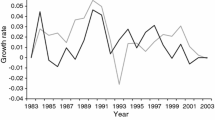Abstract
We study the employment assimilation of the recent wave of immigration in Spain for the period 2002–2006. We differentiate the immigrants by their year of arrival in Spain. Following Shimer (Am Econ Rev 95(1):25–49, 2005) and using data from the Spanish Labor Force Survey, we calculate the job finding and the job exit rates. Throughout the period, immigrants show higher job finding and job exit rates. We also present a search and matching model with search intensity, where natives, new immigrants, and old immigrants compete in the labor market. The simulated model is able to reproduce the differences observed in their job finding and unemployment rates.





Similar content being viewed by others
Notes
The Spanish Labor Force Survey is a quarterly household survey that interviews 65,000 households each period (about 200,000 individuals). Each household remains in the sample for six periods, and a sixth of them are renewed each quarter. We use the data considering the methodological changes produced in 2005. Also this year, retrospective series were calculated for the period 1996–2004 with the new population base founded in 2005, for the purpose of maintaining the homogeneity of the estimates.
In this paper, we define the immigrant population as people born outside European Union 15 (EU15).
Although gross worker flow data can be used to measure the job finding and separation rates directly, we cannot use them because, for our period, the Spanish Labor Market Survey flow data base does not give information about nationality or country of origin.
The administrative data set used by Carrasco and Pérez (2008) makes it possible to control for unobserved heterogeneity. However, their data set has some problems: For instance, it does not take into account both the irregular immigrants (employed or unemployed) and the employed workers in the informal sector (employed workers without social security). It seems reasonable to expect that irregular immigrants and informal workers will have higher job turnover rates, so these characteristics may affect their results.
As in Shimer (2007), we define the equilibrium unemployment rate as a function of the job finding and job exit rates, \(u_{t}^{*}=\frac{x_{t}}{(x_{t}+f_{t})}\), which is standard in the literature.
We calculate the coverage rate as the number of unemployed workers who receive a contributive unemployment benefit divided by the number of unemployed workers.
Patel (2008) develops a search and matching model to assess the role of professional networks differences in the observed wage and unemployment patterns for immigrants and natives. Using US data on high skill workers, she finds that, as professional networks expand, immigrants’ labor market characteristics resemble those of natives.
As the number of natives has been standardized to one, the number of unemployed natives coincides with their unemployment rate.
We calculate these coverage rates as the number of unemployed workers who receive a contributive unemployment benefit divided by the number of unemployed. We use data from Spanish Labor Force Survey.
References
Abowd J, Kramarz F (2003) The costs of hiring and separations. Labour Econ 10(5):499–530
Amuedo-Dorantes C, de la Rica S (2007) Labour market assimilation of recent immigrants in Spain. Br J Ind Relat 45(2):257–284
Borjas G, Bratsberg B. (1996) Who leaves? The outmigration of the foreign-born. Rev Econ Stat 78(1):165–176
Carrasco R, Pérez J (2008) Unemployment duration among immigrants and natives: unobserved heterogeneity in a multi-spell duration model. Working Papers 08.13, Universidad Pablo de Olavide, Department of Economics
Carrasco R, Jimeno J, Ortega-Masagué C (2008) The effect of immigration on the labor market performance of native-born workers: some evidence for Spain. J Popul Econ 21(3):627–648
Castillo S, Jimeno J, Licandro O (1998) Employment segmentation, labour mobility and mismatch: Spain, 1987–1993. Working Papers 98-04, FEDEA
Chiswick B (1978) The effect of Americanization on the earnings of foreign-born men. J Polit Econ 86(5):897–921
Chiswick B (1982) The employment of immigrants in United States. AEI studies (364). American Enterprise Institute, Washington, DC
Dolado J, Jansen M, Jimeno J (2007) A positive analysis of targeted employment protection legislation. BEJ Macroecon Topics 7(1), Art.14
Dustmann C, Weiss Y (2007) Return migration: theory and empirical evidence from the UK. Br J Ind Relat 45(2):236–256
Fernández C, Ortega-Masagué C (2008) Labor market assimilation of immigrants in Spain: employment at the expense of bad job-matches?. Span Econ Rev 10(2):83–107
González L, Ortega F (2008) How do very open economies absorb large immigration flows? Recent evidence from Spanish regions. Economic Reports 06-08, FEDEA
Izquierdo M, Lacuesta A, Vegas R (2009) Assimilation of immigrants in Spain: a longitudinal analysis. Labour Econ 16(6):669–678
Lumpe C, Weigert B (2009) Immigration policy, equilibrium unemployment, and underinvestment in human capital. Lab Rev Lab Econ Ind Relat 23(1):97–130
OECD (2007) International migration outlook. OECD, Paris
Patel K (2008) Network effects on labor markets for immigrants and natives: its what you know and whom you know. SSRN 1373885
Pissarides C (2000) Equilibrium unemployment theory, 2nd edn. MIT, Cambridge
Shimer R (2005) The cyclical behavior of equilibrium unemployment and vacancies. Am Econ Rev 95(1):25–49
Shimer R (2007) Reassessing the ins and outs of unemployment. NBER Working Papers 13421, National Bureau of Economic Research, Inc
Warren R, Peck J (1980) Foreign-born emigration from the United States. Demography 17:71–84
Acknowledgements
We gratefully acknowledge the insightful comments and suggestions received by Luis Ayala, two anonymous referees, and the editor, James Albrecht. The authors acknowledge the Instituto de Estudios Fiscales (Institute of Fiscal Studies, Ministry of Finance, Spain) for its financial support. Javier Vázquez Grenno also benefited from the Spanish Science and Technology System (project N° SEJ2006-04444) and the Catalan Government Science Network (project N° SGR2009-600 and Xarxa de Referencia d’R+D+I en Economia i Politica Publiques, (XREPP)).
Author information
Authors and Affiliations
Corresponding author
Additional information
Responsible editor: James Albrecht
Rights and permissions
About this article
Cite this article
Silva, J.I., Vázquez-Grenno, J. The ins and outs of unemployment and the assimilation of recent immigrants in Spain. J Popul Econ 24, 1309–1330 (2011). https://doi.org/10.1007/s00148-010-0315-y
Received:
Accepted:
Published:
Issue Date:
DOI: https://doi.org/10.1007/s00148-010-0315-y




